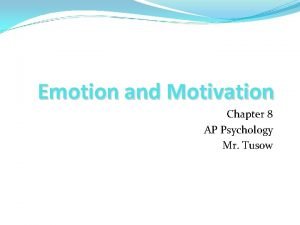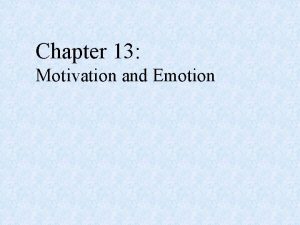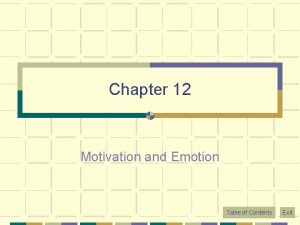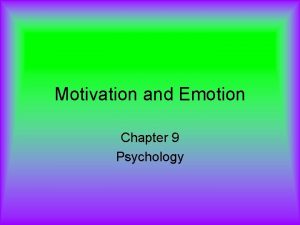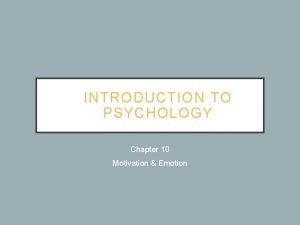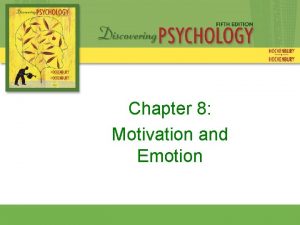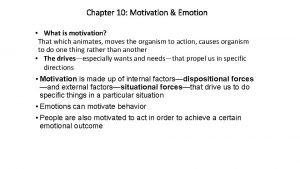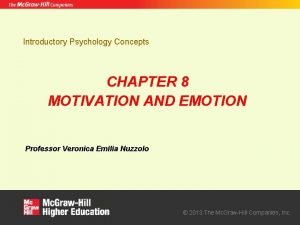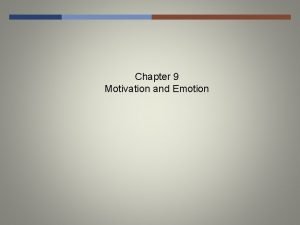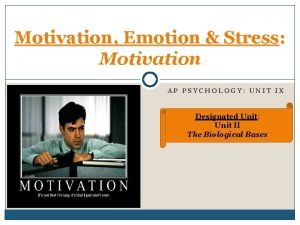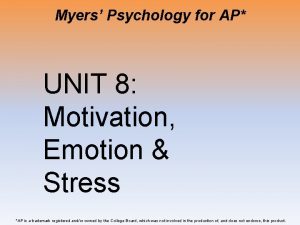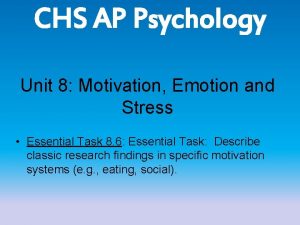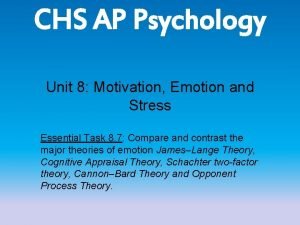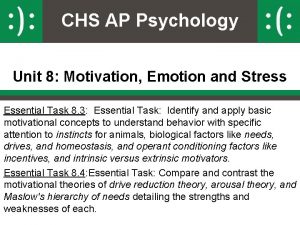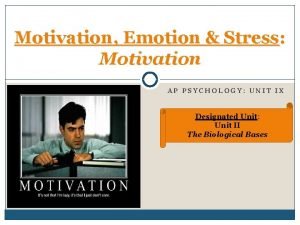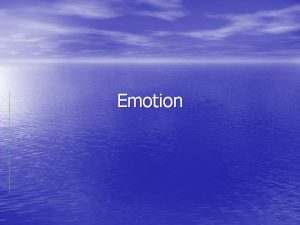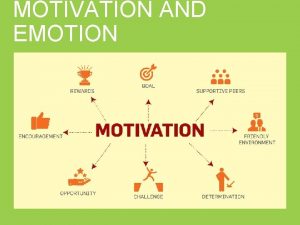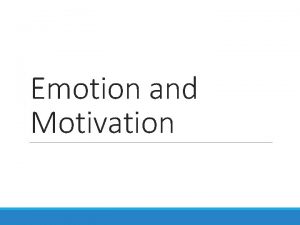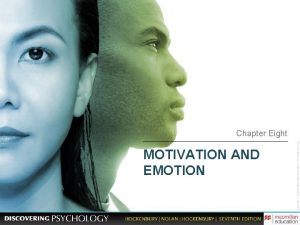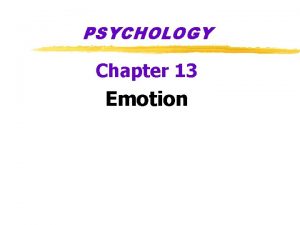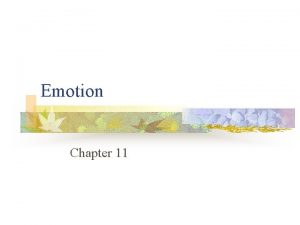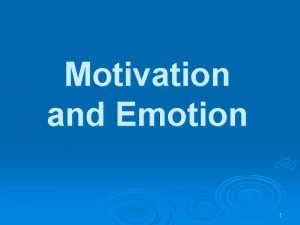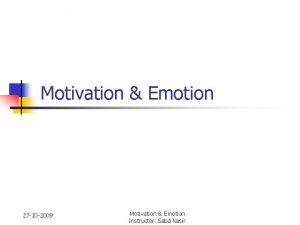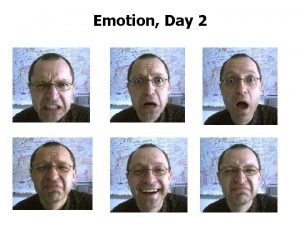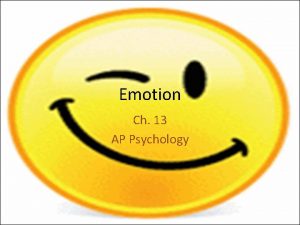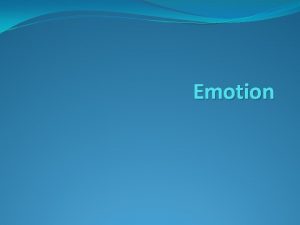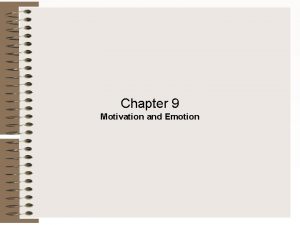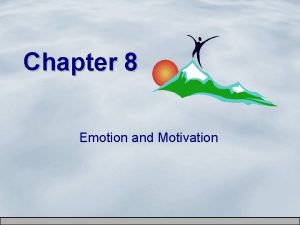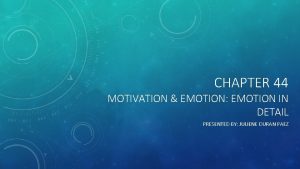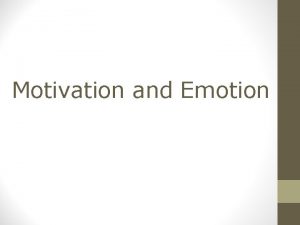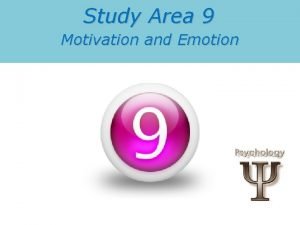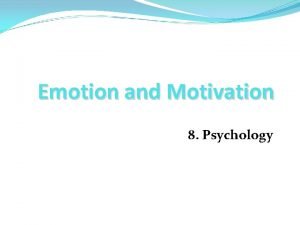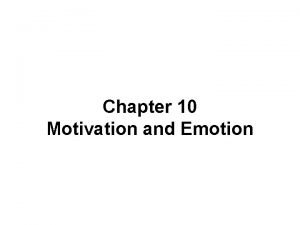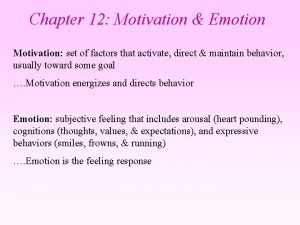Chapter 10 Motivation Emotion What is motivation That























- Slides: 23

Chapter 10: Motivation & Emotion • What is motivation? That which animates, moves the organism to action, causes organism to do one thing rather than another • The drives—especially wants and needs—that propel us in specific directions • Motivation is made up of internal factors—dispositional forces —and external factors—situational forces—that drive us to do specific things in a particular situation • Emotions can motivate behavior • People are also motivated to act in order to achieve a certain emotional outcome

Biological Theories of Motivation: Instinct Theory • Early theories of motivation focused on instincts as being the primary motivator of human behavior • To qualify as an “instinct, ” a behavior must be (1) unlearned (occurs naturally without any prior experience) and (2) follow a fixed pattern across all members of a species • Variability in human behavior is problem for instinct theory • Most psychologists now believe human behavior is motivated by a combination of biological and psychological states

Bio Theories of Motivation: Drive Reduction Theory • According to drive-reduction theory, we act when a physiological need creates an aroused state that drives us to reduce the need • Humans are motivated to maintain a state of homeostasis—a state of balance or equilibrium • Primary vs. secondary drives • Limitations include: understanding how secondary reinforcers serve to immediately reduce drives and why humans are motivated to behave in ways that increase arousal and disrupt homeostasis

Bio Theories: Optimal Arousal Theory LO 10. 3 Explain how the Yerkes-Dodson law applies to the optimal arousal theory of motivation. • Optimal arousal theory of motivation states that people are driven to achieve an ideal level of arousal • Yerkes-Dodson law states that performance generally peaks with a moderate level of arousal

Factors Influencing Hunger. • One area where biological theories of motivation have been applied frequently is in eating behavior and associated disorders • Hormone levels such as insulin and cues in the brain such as from the hypothalamus influence the physiology of hunger • Lateral (initiating eating) and ventromedial (stopping eating) hypothalamus in conjunction with other parts • Leptin, a hormone released from the fat cells located in adipose tissues, sends signals to the hypothalamus in the brain, which in turn brings on satiation, reducing appetite. • The gustatory sense—taste—also impacts hunger • We appear to have an innate preference for sweet, high-fat foods because consumption of these foods would have provided an evolutionary advantage • How much we eat and what types of foods we consume can also depend on the context and culture

Obesity LO 10. 5 Identify some of the factors that impact obesity. • Obesity is caused by an imbalance between energy consumed and energy spent • Genetic contributions and the metabolic system basal metabolic rate (BMR) play a role • In obese people, leptin levels are often high, suggesting that the brain isn’t receiving the message that would signal satiety (leptin insensitivity or resistance)

Table 10. 1 Adult Body Mass Index (BMI) is a ratio of a person’s height to weight. BMI is an indicator of level of body fat. • • If your BMI is less than 18. 5, it falls within the underweight range. If your BMI is 18. 5 to 25, it falls within the normal range. If your BMI is 25 to 30, it falls within the overweight range. If your BMI is 30 or higher, it falls within the obese range. Obesity is frequently subdivided into categories: • Class 1: BMI of 30 to 35 • Class 2: BMI 35 to 40 • Class 3: BMI of 40 or higher. Class 3 obesity is sometimes categorized as “extreme” or “severe” obesity. Criticism of BMI: does not take into account muscle mass, bone density, overall body composition

Figure 10. 1 Inactivity Rate from 2010 -2015 • Two main environmental contributors to obesity are: (1) diets based on processed foods high in fat and carbohydrates and low on nutrients and (2) lack of physical activity (above).

Maslow’s Hierarchy of Needs Self-transcendence: the overcoming of the limits of the individual self and its desires in spiritual contemplation and realization (peak experiences)

Intrinsic and Extrinsic Motivation LO 10. 7 Distinguish between intrinsic motivators and extrinsic motivators. • Extrinsic motivation occurs when people are motivated to engage in a behavior to gain a reward or to avoid a negative outcome • Intrinsic motivation is engaging in a behavior for its own sake rather than the desire to obtain an external goal or reward • For behaviors that are already driven by intrinsic motivation, adding an external incentive can serve to decrease motivation, which is known as the overjustification effect

Self-Determination Theory LO 10. 8 Explain the roles of autonomy, relatedness, and competence in self-determination theory. • Self-determination theory (SDT) states that it is part of human nature to be curious, vital, and self-motivated • These psychological needs must be satisfied in order to facilitate the tendency toward human growth: autonomy, relatedness, and competence • When these needs are fulfilled there will be positive outcomes such as increased self-esteem • If these needs are not fulfilled, there are negative outcomes such as increased psychological distress • Criticism: may be more true of Westerners than Easterners (especially autonomy)

Dweck’s Self-Theory of Motivation LO 10. 9 Summarize Dweck’s self-theory of motivation. • Successful people have mastery-oriented qualities that include a love of learning, seeking challenges, valuing effort, and persistence in the face of obstacles • People who have a fixed mindset view intellectual ability as an entity that dwells within us that we cannot change • In a growth mindset, people believe that intellectual ability is a malleable construct that can be changed with effort • Praising a child for effort will lead them to confront difficulties as a challenge and an opportunity for growth

Emotion • What is emotion? -- Mental states or feelings (affective states) associated with our evaluation of our experiences • Physiology plays a critical role in emotion: Emotion necessarily involves physiological responses in the body • The sympathetic and parasympathetic components of the autonomic nervous system help us prepare for and recover from emotionally charged actions • The prefrontal cortex is essential for the cognitive experience of emotion • But some emotional reactions can bypass our conscious mind such as with the exposure effect (subliminal exposure or attended exposure leading to positive affect). • Many emotions have physiological similarities

Figure 10. 2 High Road vs. Low Road

Behavior and Emotion LO 10. 11 Identify some of the ways we detect and express emotions. • The universality hypothesis proposes that facial expressions are understood across all cultures • Blind children who have never seen facial expressions will express emotions in the same way as sighted people • Women have demonstrated the ability to express happiness better than men, and men have expressed anger better than women • Physical gestures and degree of emotional expression vary among cultures • Expressions of genuine emotions differ from false ones

Universality of Emotions • • If evolutionary in nature, emotions should be universal. Good support for seven primary emotions: – Happiness, disgust, fear, sadness, surprise, anger, and contempt – “Pride” may also be a primary emotion. • • Ekman & Friesen (1978) identified six universal facial expressions: joy (happiness), fear, anger (contempt), sadness, surprise and disgust. Later research has called this into question. Debate continues

Faking emotions • Real vs. fake emotions – Certain components of facial expression allow us to distinguish when someone is showing a genuine emotion. – Duchenne vs. Pan Am (fake) smiles • The Duchenne smile involves both voluntary and involuntary contraction from two muscles: the zygomatic major (raising the corners of the mouth) and the orbicularis oculi (raising the cheeks and producing crow's feet around the eyes). • A fake smile or "Say Cheese" smile involves the contraction of just the zygomatic major since we cannot voluntarily contract the orbicularis oculi muscle. • orbicularis oculi controlled involuntarily by limbic brain structures • “Real smiling” in college year book associated with greater life satisfaction and better marriage outcomes 30 years later!

Cognition and Emotion • Cognition, or thought, can influence what we feel or believe we feel • Misattribution sometimes leads people to attribute their arousal to the wrong stimulus (Angry at boss, kick the dog; next slide) • Our emotions can influence what we choose to perceive through moodcongruent processing • In emotion regulation, we use cognitive strategies to control and influence our own emotional responses Emotional regulation: freethrow routines

Figure 10. 3 Dutton and Aron (1974) Bridge Study As shown in Figure 10. 3, they found that the men who were interviewed while walking across the suspension bridge were more likely to call the female and ask her out on a date following the study than the participants who had finished crossing. The authors hypothesized that the physiological arousal (for example, increased heart rate, rapid breathing) of walking the bridge led men to misattribute their feelings to attraction to the female interviewer.

Theories of Emotions • The James-Lange theory argues that physiological experience precedes emotion (e. g. , you experience the emotion of sadness because you are crying) • In the Cannon-Bard theory, the mental and physiological components of emotions happen simultaneously • The Cannon-Bard theory has some support from basic neuroscience regarding the way that sensory information is transmitted

Table 10. 2 Schachter and Singer (1962) Theories of Emotions • The two-factor theory of emotion, states that the cognitive evaluation following physiological arousal creates the emotion we experience Situation Cues Participants’ Expectation Informed (expected symptoms of arousal) Misinformed (did not expect symptoms of arousal) Confederate is angry Participants’ emotions are generally unaffected Participants tend to exhibit anger Confederate is happy Participants’ emotions are generally unaffected Participants tend to exhibit happiness

Theories of Emotions

Facial feedback hypothesis states that you are more likely to feel emotions that correspond to your facial expression or configuration. “Cool Brain” Hypothesis Theories of Emotions ©John Wiley & Sons, Inc. 2007 in Action (8 e) Huffman: Psychology
 Motivation ap psychology
Motivation ap psychology Chapter 13 motivation and emotion
Chapter 13 motivation and emotion Chapter 12 motivation and emotion
Chapter 12 motivation and emotion Example of motivation
Example of motivation Paul ekman universal facial expressions
Paul ekman universal facial expressions Chapter 8 motivation and emotion
Chapter 8 motivation and emotion Chapter 10 motivation and emotion
Chapter 10 motivation and emotion Chapter 8 motivation and emotion
Chapter 8 motivation and emotion Psychology chapter 9 motivation and emotion
Psychology chapter 9 motivation and emotion Chapter 9 motivation and emotion
Chapter 9 motivation and emotion William masters ap psychology
William masters ap psychology Myers ap psych unit 8 vocab
Myers ap psych unit 8 vocab Unit 8 motivation emotion and stress
Unit 8 motivation emotion and stress Two factor theory psychology
Two factor theory psychology Ap psychology unit 8 motivation emotion and stress
Ap psychology unit 8 motivation emotion and stress Unit 8 motivation and emotion
Unit 8 motivation and emotion Alfred kinsey ap psychology
Alfred kinsey ap psychology Ngoại tâm thu thất chùm đôi
Ngoại tâm thu thất chùm đôi Block xoang nhĩ ecg
Block xoang nhĩ ecg Thơ thất ngôn tứ tuyệt đường luật
Thơ thất ngôn tứ tuyệt đường luật Thơ thất ngôn tứ tuyệt đường luật
Thơ thất ngôn tứ tuyệt đường luật Chiến lược kinh doanh quốc tế của walmart
Chiến lược kinh doanh quốc tế của walmart Tìm vết của mặt phẳng
Tìm vết của mặt phẳng Con hãy đưa tay khi thấy người vấp ngã
Con hãy đưa tay khi thấy người vấp ngã
